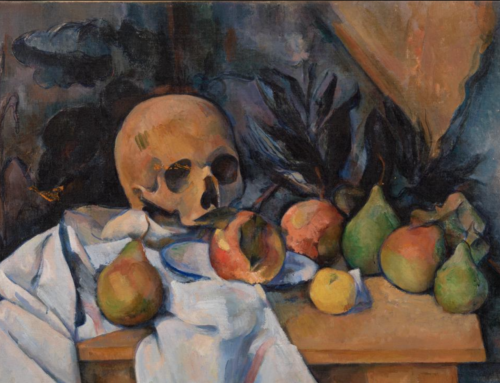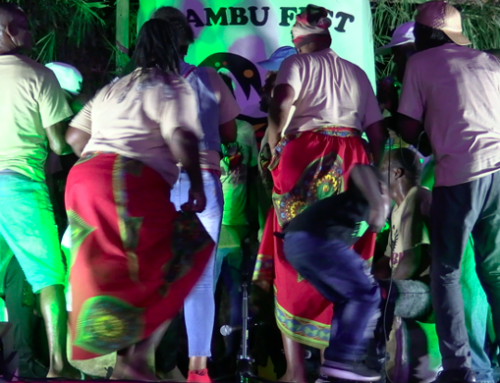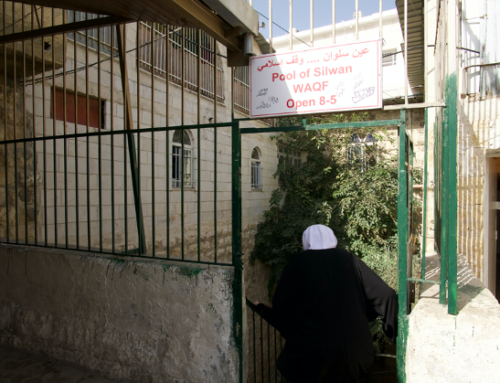“Revolutions are consummately about time” (Scott 2014, 15); and, as Hannah Arendt argued—they are “the only political events which confront us directly and inevitably with the problem of a beginning” (1965, 21). But what happens, as is often the case, when a revolution is experienced as incomplete—as endless? What happens to the experience of time, and to attempts to mediate it through text and image?
These issues are at the heart of Abdallah al-Khatib’s accounts of the siege of Yarmouk (2012-18), one of the most contested episodes of the Syrian Revolution (2011–?). I first met Abdallah at a workshop in Istanbul organised by the Syrian organisation Bidayyat, aimed at helping activists turn their footage into films. He had crossed over into Turkey from Syria a week earlier. While playing footage shot during siege, he read from a text written under siege:
Rule number 29:
The siege is an eternal wager between two times that will never meet, that’s how the besieged feels
A cunning present [hāḍirun mākirun] witnessing a war within us between the past and the future, a struggle over which of the two will produce hope from the midst of massacres
This siege will be a raging epidemic spreading like oil over your personal past, it will eradicate within you that which you once tried to become
Neither tomorrow’s future nor yesterday’s past, says the siege
And yet the siege is only a temporary crossing between two times, says the historian:
An endless past and a future yet to come
A deep wound within your personal history, ripping out your past like a fistful of wool by a gloved hand
The siege is an interruption in rational time; so, make do with the irrational
(Al-Khatib n.d., The Forty Rules of Siege, emphasis added)
It was striking that the combination of text and image shifted attention from the constraints on space under siege to the experience of time. Siege—the revolution driving out the regime yet hitting a military deadlock, the paradoxical condition of freedom within the boundaries of confinement—gave rise to “a cunning present.” It’s a time when neither “yesterday’s past” nor “tomorrow’s future” offer resources for plotting a way out. Abdallah al-Khatib and other young activists who had survived the siege—as well as from the images and texts of those who didn’t—experienced time as out of joint in two senses: the first political, the second generational.
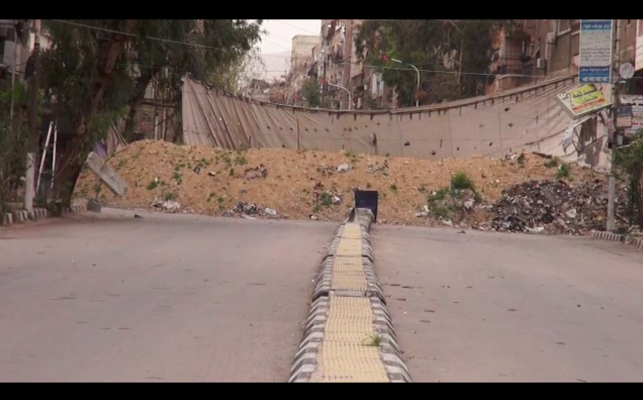
Figure 1. Still from a rough cut of Abdallah al-Khatib’s film
Accounts of the siege of Yarmouk are highly contested. In Syria’s fraught discursive field prior to 2011, where public utterance and private belief had been wrenched apart by state power (Wedeen 1999), the Assad regime’s support for the Palestinian cause generated rare coherence and consensus (Kiwan 2011). Yarmouk was the largest concentration of Palestinians outside Palestine, widely known as the “capital of the diaspora.” It was a suburb rather than camp in all but name (Al-Hardan 2016). In Palestinian camps in Syria, Yarmouk stood for the “promise” of development, and the “threat” of “blurring” distinctions between Palestinian and Syrian identities (Gabiam 2016, 2–3). Conversely, the blurring of boundaries meant Yarmouk’s residents shared the grievances of other Syrians. When I lived in Damascus in 2007-8, students from across the city hung out there, a youthful scene captured in Les Chebabs de Yarmouk (dir. Salvatori-Sinz 2013).
In 2012, Assad forces proved they could swiftly (re)impose Yarmouk’s status as a camp. In the siege’s disputed chronology, there is agreement that a MiG airstrike by Assad forces on December 16, 2012 marked the beginning. In the weeks that followed, Assad claimed Yarmouk had been “infiltrated” by “terrorists”; factions allied to Assad were forced out of the camp; and Assad forces bombed then besieged the camp. Many residents fled, and siege was imposed on the 30,000 who remained (Salamah 2016).
During six years of siege, there were two episodes of “total siege,” according to Khaldoun al-Mallah (Conversation, WhatsApp, November 13, 2023). The first from July to December 2013, the second during the winter of 2014-2015. Khaldoun, one of the few medics in Yarmouk during these periods, estimated that starvation claimed 188 lives. Otherwise, Yarmouk was under “partial siege,” meaning some humanitarian aid was allowed to enter until a “local truce” was negotiated in April 2018. The last convoys of “green buses” left the camp carrying fighters and activists who refused “reconciliation” (musālaha) in May 2018. The siege ended in total displacement and destruction. Today, Yarmouk exists only in name and narrations.
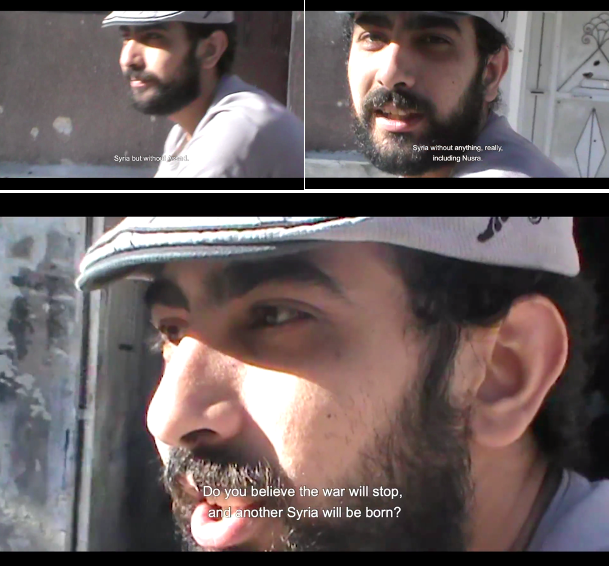
Figure 2. Hassan Hassan’s inconclusive last interview, stills from Little Palestine (Diary of a Siege). (Al-Khatib 2021).
Before leaving on a green bus, Abdallah al-Khatib, Khaldoun al-Mallah, Ahmed Amer and a few other young activists founded a platform called Sard (trans. narrative) to document their time under siege [1]. I first met Abdallah a month later at the Bidayyat workshop. Khaldoun remained in Idlib, Northern Syria. We have never met, but I began reading his essays in 2020 and we correspond via WhatsApp.
From 2012-18, the besieged Palestinians were united in their commitment to remain lest they fell victim to displacement, conceived as another Nakba, in reference to the 1948 ethnic cleansing of Palestine to create the state of Israel. Yarmouk had been founded by Palestinian refugees fleeing the Nakba, and history, they felt, was repeating itself. Abdallah al-Khatib described the temporal relation to an originary catastrophe in a funding application to turn his footage into a feature film:
Towards the beginning of the siege, I would repeat a famous line of poetry: “Besiege your siege with madness / and with madness / and with madness.”[2] I didn’t realise at the time that madness would become more than metaphor; everything determinate about reality became distant, and madness began to fill this symbolic space. Something inside me said that our victory in the siege of Yarmouk would be a symbolic reformulation of history, that this siege really did stretch back to the sieges of Tel al-Zaatar and West Beirut. Similarly, and without any prompting, the majority of the elderly who’d left Palestine seventy years earlier during the Nakba, announced spontaneously their refusal to leave the camp, which had been transformed into a new Palestine, besieged by an enemy that had finally revealed its true face. That’s how all the symbolic language of the Palestinians inside the camp was assembled in order to overcome the siege.
(The Yarmouk Ghetto [working title], author’s translation, 6 February 2019.)
For the besieged Palestinians in Yarmouk, the Nakba isn’t an event; it’s a structure determining their political-temporal experiences in the present. As such, it initiates an intellectual tradition narrating displacement and siege in poetry and prose, which Abdallah al-Khatib and others draw on and contribute to.


Figure 3. Stills from 4th Floor After the Nakba (Salameh 2018). Hassan Hassan’s father talks to him about the recurrence of the past.
However, the political impasse during the siege of Yarmouk wasn’t only manifested in the external relations between a Palestinian community and a postcolonial state revealing its colonial face. It was also refracted through generational relationships between Palestinians, who understood the lessons to be learnt from the Nakba differently. Many young Palestinians embraced the Syrian Revolution, made common cause with its grievances, and remained committed to a joint struggle for freedom, dignity and justice. The older generation, conversely, berated the young for joining the revolution, recklessly breaching the camp’s uneasy neutrality, and exposing the camp to the threat of another displacement.
It was during the siege and under a double disjuncture—generational and political—that Abdallah al-Khatib formulated his temporal experiences in terms of “a cunning present.” For the young Palestinians who threw in their lot with the Syrian revolution, the longing for total revolution should be driving them forward, imbuing them with a belief in an eventual rupture with the status quo. However, they experience neither progressive nor cyclical time. It is also neither chronos nor kairos, homogenous empty time or the opportune moment ripe to be seized (Kermode 1967, 46–47). Siege gave rise to an in-between temporality, during which neither the rational order of progress; the divine order of apocalypse; nor the naturalistic order of cyclical repetition could triumph. “So, make do with the irrational,” Abdallah counsels. I came to understand Abdallah’s phrase as a comment on the revolutionary experience in Syria (and perhaps the Arab revolutions more generally): neither the lessons of the past nor hope for the future could plot a way through the present predicament. They experience what Abdallah calls “a cunning present”, a contradictory feeling of time passing as stasis.
Giorgio Agamben recently theorised stasis as the moment when the boundaries between family and city are breached. Elements belonging in one domain pollute the other, leading to disorder. Paradoxically, order can be restored by adopting elements from the other: civic life overrun by kinship ties amounts to civil war; conversely, political reconciliation can be sought through notions of “false” kinship, such as “political fraternity” (Agamben 2015, 8–9). However, Agamben doesn’t connect stasis with theories of revolution—nor with theories of temporality and narrativity.
In classical philosophy and historiography, stasis punctuates the cyclical movement of constitutional forms: monarchy to tyranny, aristocracy to oligarchy etc. In the Politics, Aristotle “includes an elaborate taxonomy of stasis, and even advice on how stasis can be avoided” (Finley 1962,7–8). Stasis, however, has largely fallen out of conceptual histories of revolution. When Reinhart Koselleck theorised the pre-modern concept of revolution as a cyclical movement between “constitutional forms, which dissolve and replace each other but couldn’t naturally coincide” (2004, 45), he didn’t mention stasis – the time in-between, which anthropologists writing on revolution in the idiom of ritual theory might otherwise call liminality (Thomassen 2012; Armbrust 2019).
In the wake of the siege, the young activists and writers from Yarmouk have been publishing their experiences on the Sard platform. Their narratives structure their experiences of time and vice versa; their experiences of time delimit the appropriateness (availability?) of genres. Paul Ricœur theorised this circular relationship between temporality and narrativity as virtuous; but he was aware it could be cast as “vicious”. Ricœur describes an “endless spiral” in the circling between the experience of time and the emplotment of narrative that returns to the same point “a number of times, but at different altitudes” (1984, 72). The co-constitutive spiral between temporality and narrativity resonates with the image of a cunning present.
David Scott has argued that, “what our present solicits from us most urgently is an attunement to tragedy” (2014a, 2). For Scott, “our present” is the postcolonial present and “tragedy” is a kind of emplotment that allows for the (postcolonial critic’s) cathartic reconciliation with the history anticolonial struggle and the anticolonial generation’s intellectual productions. Scott’s intervention entails considering both the historicity of the object (for example, the narrative genre of an intellectual production), the temporality of the subject (e.g. the intellectual), and the critic’s relation to them in the present as all “saturated with time” (Scott 2014b, 163). Scott’s argument is both necessary and convincing. However, while Palestinian intellectuals have been central to the formation of a body of theory called “postcolonial,” Palestinian experience has an awkward (to say the least) relationship with postcoloniality.

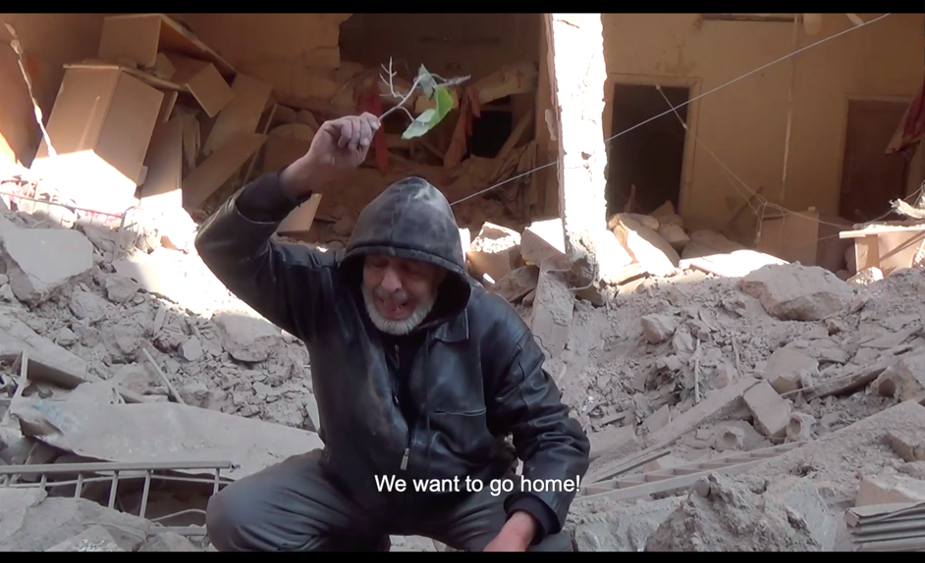
Figure 4. The older generation’s tragic discourse; the younger generation’s tragicomic stance towards it. Stills I subtitled from a rough cut of Abdallah al-Khatib’s film that weren’t included in the final cut.
In his discussion of the Palestinian Authority in the West Bank, an ersatz version of the Arab security state established while still under colonial rule, Nasser Abourahme describes their present predicament “as the tragedy of the postcolonial without the triumph, however pyrrhic, of the anti-colonial” (2016, 151). It’s a suspended temporality Helga Tawil-Souri (2017) theorises as “checkpoint time”. The predicament facing young Palestinians in Yarmouk bears a family resemblance with this grammar of power: They lived the tragedy of postcolonial rule, struggled against it by joining a larger political movement, while continuing to long for anticolonial liberation and ultimately return. The outcome was a siege, unlike in the West Bank (but, in this respect, similarly to Gaza). What genres are appropriate for its emplotment?
In “Shitting on/at the Checkpoint,” Khaldoun al-Mallah opens with an image of “compromise” between the tragic and comic symbolised by two philosophers, Democritus and Heraclitus.[2] Khaldoun’s essay describes his attempts to treat a patient suffering from severe constipation “due to intestinal obstruction” during the starvation siege. When treatment fails, Khaldoun manages with difficulty to organise his transfer out of the siege. An ambulance transports him to the edge of Yarmouk, but the patient has to get out and walk the final stretch to the checkpoint. As he hands over his papers, face to face with the forces besieging him, the patient shits himself—and shits on/at the checkpoint. “His terror at that point,” Khaldoun writes of the profanation, “was admixed with such overwhelming pleasure.” He is cured, he’s alright. But he thinks he’s going to be killed for defiling the checkpoint. He’s terrified; is he going to be alright? Despite the profane power of shitting, the soldier shows mercy.
The ending is inconclusive; the narrative is open to contradictory interpretations. The patient is cured, humiliated, saved, still besieged…What genre does it belong to? Is it the “imitation of an action,” as in Aristotle’s famous definition of tragedy in the Poetics (Part VI), that is “serious and also, as having magnitude, complete in itself”? The illness was entirely serious but the telling is not. Is (this kind of) shitting even an act? Is the story a cathartic representation of suffering that engenders fear and pity? In part, but it also represents a kind of (light) relief from suffering.
By allowing the tragic and comic to accumulate without resolving their contradictions, Khaldoun and other Sard writers narrativise a temporality that emerged under siege and has continued in its wake. What, then, does the attunement to the tragicomic reveal about this present? Tragedy, as Scott writes via Arendt, is the consoling cost of embarking on a free course of action under historical constraints; while comedy, as Cavell (1958) has suggested, is the stance one can take faced with the unfreedom of arbitrary and overwhelming power. The besieged Palestinians were in both positions.
The tragicomic is an inconclusive genre, a modality that sits at an awkward relation to both the anti- and post-colonial, two parts that add up to an excess. In this present, the past is experienced as “an apocalypse that will not stop rearriving” (McManus 2021, 47), a “past continuous” (Allan 2021); while the expectation of a better future induces “a mood of hilarity which does not produce laughter” (Cavell 1958, 135). As historical subjects, the cunning present solicits a consoling reconciliation with the tragic choices of struggle through an awareness of the contingency of action in history. Conversely, the comic presents the besieged not as actors but as acted upon—not subjects, but objects. It’s elicited by the absurd alienation of being at the mercy of powers that can choose arbitrarily whether to leave you besieged, displace you, or crush you.
Notes
[1] For an English-language introduction to Sard, see the essay by Khaldoun al-Mallah, ‘The Heron’s Song: An Introduction to Sard’ in World Records Journal, Volume 8 “Generations” (2023): 97–99, https://worldrecordsjournal.org/the-herons-song/. The journal issue also includes English translations of three Sard essays.
[2] Mahmoud Darwish, “مديح الظل العالي”, 1983. https://www.aldiwan.net/poem6688.html (accessed 22 January 2023). The poem was written in the wake of the Israeli siege of West Beirut in 1982.
[3] Khaldoun was writing under the pseudonym Abū al-Khulūd (2020). The image of the two philosophers recalls Samuel Beckett’s writing on the tragicomic in the wake of the Second World War: “Democritus laughed at Heraclitus weeping and H. wept at D. laughing. Pick yr fancy” (see Turley 2020).
References
Abourahme, Nasser. 2016. ‘The Productive Ambivalences of Post-Revolutionary Time: Discourse, Aesthetics, and the Political Subject of the Palestinian Present’. In Time, Temporality and Violence in International Relations: (De)Fatalizing the Present, Forging Radical Alternatives, edited by Anna M. Agathangelou and Kyle D. Killian. London: Routledge.
Abu al-Khuloud. 2020. ‘لما تخرا عالحاجز [Shitting on/at the checkpoint]’. Sard (blog). 29 November 2020. https://sard.network/2020/11/30/لما-تخرا-عالحاجز/.
Agamben, Giorgio. 2015. Stasis: Civil War as a Political Paradigm (Homo Sacer II). Translated by Nicholas Heron. Stanford, CA: Stanford University Press.
Al-Hardan, Anaheed. 2016. Palestinians in Syria : Nakba Memories of Shattered Communities. New York: Columbia University Press.
Al-Khatib, Abdallah. n.d. قواعد الحصار الاربعون [The Forty Rules of Siege]’. Translated by Stefan Tarnowski. Unpublished.
—. 6 February 2019. The Yarmouk Ghetto (working title). Funding application. Translated by Stefan Tarnowski. Unpublished.
—Little Palestine (Diary of a Siege). Documentary. Bidayyat for Audiovisual Arts, Films de Force Majeure, 2021.
Allan, Diana. 2021. ‘Introduction: Past Continuous’. In Voices of the Nakba: A Living History of Palestine, edited by Diana Allan, 1–19. London: Pluto Press.
Arendt, Hannah. 1965. On Revolution. New York: Penguin Books.
Armbrust, Walter. 2019. Martyrs and Tricksters: An Ethnography of the Egyptian Revolution. Princeton Studies in Muslim Politics. Princeton, New Jersey: Princeton University Press.
Cavell, Stanley. 1958 “Ending the Waiting Game.” In Must We Mean What We Say?, 107–50. Cambridge: Cambridge University Press.
Finley, M. I. 1962. “Athenian Demagogues.” Past & Present 21: 3–24.
Gabiam, Nell. 2016. The Politics of Suffering: Syria’s Palestinian Refugee Camps. Bloomington: Indiana University Press.
Kermode, Frank. 1967. The Sense of an Ending. Oxford: Oxford University Press.
Kiwan, Charif. 2011. “Les Syriens ont défié et brisé la loi du silence.” Le Monde, 31 March 2011. https://www.lemonde.fr/idees/article/2011/03/31/les-syriens-ont-defie-et-brise-la-loi-du-silence_1501276_3232.html.
Koselleck, Reinhart. 2004. Futures Past : On the Semantics of Historical Time. New York: Columbia University Press.
McManus, Anne-Marie. 2021. “On the Ruins of What’s to Come, I Stand: Time and Devastation in Syrian Cultural Production since 2011.” Critical Inquiry 48(1): 45–67.
Ricœur, Paul. 1984. Time and Narrative. Translated by Kathleen McLaughlin and David Pellauer. Chicago: University of Chicago Press.
Salamah, Salim. 2016. “The Unacknowledged Syrians: Mobilization of Palestinian Refugees of Yarmouk in the Syrian Revolution.” Confluences Mediterranee 99(4): 47–60.
رابع فني بعد النكبة Fourth Floor After The Nakba, 2018. Bidayyat for Audiovisual Productions. https://www.youtube.com/watch?v=4lbdPob2Zj0.
Salvatori-Sinz, Axel, dir. 2013. Les Chebabs de Yarmouk. Documentary. Adalios, Andana Films, Taswir Films.
Scott, David. 2014. Omens of Adversity : Tragedy, Time, Memory, Justice. Durham: Duke University Press.
Tawil-Souri, Helga. 2017. “Checkpoint Time.” Qui Parle: Critical Humanities and Social Sciences 26(2): 383–422.
Thomassen, Bjørn. 2012. “Notes towards an Anthropology of Political Revolutions.” Comparative Studies in Society and History 54(3): 679–706.
Turley, Elliott. 2020. “The Tragicomic Philosophy of Waiting for Godot.” Modern Language Quarterly 81(3): 349–75.
Wedeen, Lisa. 1999. Ambiguities of Domination: Politics, Rhetoric, and Symbols in Contemporary Syria. Chicago: University of Chicago Press.
Stefan Tarnowski is an Early-Career Research Fellow at Corpus Christi College, Cambridge, and a postdoctoral researcher on the ‘Views of Violence’ project at the University of Copenhagen.
Cite As: Tarnowski, Stefan. 2024. “A Cunning Present”, In “Back to the Present” edited by Timothy P.A. Cooper, Michael Edwards & Nikita Simpson, American Ethnologist website, January 26 2024, [https://americanethnologist.org/online-content/collections/back-to-the-present/a-cunning-present/]
